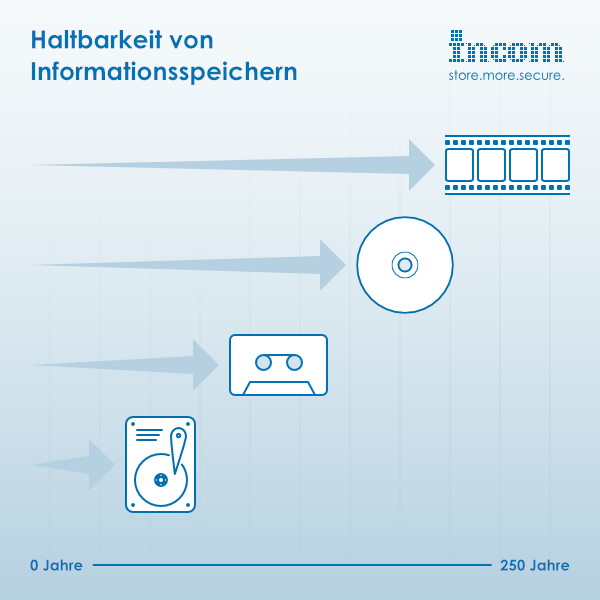Films from celluloid / microfiche:Can last 100 years and more under optimal conditions. Before digitization, these were mainly used in libraries and state archives, which then stored the microfilms in old mine galleries.
Optical storage media: With CD-Rs, durability depends extremely on the reflective layer used, which in the best case is made of corrosion-resistant gold. These gold or silver media, which are specially produced for archiving, are certified by manufacturers such as Falcon or, in the past, Sony DADC, to have a durability of up to 200 years.
The same applies to DVD-R, which however, due to the different manufacturing processes, has a durability of "only" about 35 years.
With BD-Rs (Blu-ray) the figures rise again to 200 years, as with the CD-R, whereby the values here naturally depend again on the media used, because only designated archive media achieve these values, as calculations of artificial ageing in climate chambers show.
Important for all optical media, as well as for all other data media, is storage at below 25 degrees and 80% humidity. The biggest advantage of optical data media is above all their compatibility, because all CD data media from the very beginning can still be read and written in any standard Blu-ray drive.
Hard disks: For disks in computers or storage systems, such as raids or NAS systems, the life span is about five years. It is important to pay attention to which type of disk is used for which application, because a simple desktop hard disk will rarely reach the 5 years in continuous use.
Magnetic tapes: The service life of tapes is at least 30 years if they are stored and cared for properly. For this purpose, the tapes must be wound regularly to maintain the magnetism and must not be read too often, so that the information layer is not rubbed off the carrier tape. However, it is then even more difficult to find a read drive, because usually the compatibility of the tapes is limited to 1-2 generations, so that a 10 year old LTO tape is hardly readable in a current drive.
Flash memory: This group includes a wide variety of data carriers, such as USB sticks, SD cards or solid state drives (SSD). For all of them, the number of available memory cells decreases over time with the number of read/write cycles. Well-known manufacturers such as Intel, Sandisk and Samsung specify a shelf life of at least five years for an SSD, while cheaper noname models with Multi Level Cells should only be expected to last about three years. In contrast to hard disks, where professionals can still recover data, data from flash memory is usually more difficult to recover. This is due, among other things, to the non-standardized read and write procedures of the controllers used, which determine access to the memory cells. Almost every manufacturer brews its own soup here. Especially with USB sticks and SD cards, regular copies should be made.
Holographic memories: have not yet been developed to market maturity. Products with 500 GByte and 1 TByte storage capacity have been announced by various companies such as Inphase, NTT, Tesa Scribos or General Electric, but still cannot be purchased as a serial product. Therefore it is difficult to give an estimated lifetime.
In summary, every storage technology has its advantages and a fixed place in the storage pyramid. While flash and hard disks are indispensable for operative use, only tape as a backup medium can guarantee a fast recovery of data in case of damage. Data that must be stored for 10 years or more, as in long-term archiving, but which is less frequently accessed, is best stored on optical data carriers, where it can be stored for a long time without maintenance and does not consume any power. If, on the other hand, the information to be stored does not need to be accessed at all and does not need or want to make it digitally accessible, Mircofilm may still be a good choice.
